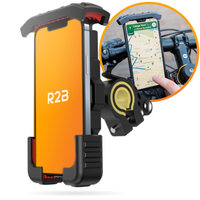No Products in the Cart

How do you inflate a bicycle tire?
Time to read 4 min
Time to read 4 min
How do you inflate a bicycle tire?
A properly inflated bicycle tire is crucial for a safe and comfortable cycling experience. Not only does it improve the efficiency of your ride by reducing rolling resistance, but it also protects against common problems such as punctures. In this article we delve into the world of inflating bicycle tires, from the different types of valves and pumps to a step-by-step guide to inflating your tires.
Valves: There are three main types of valves found on bicycle tires:
Bicycle pumps: The choice of pump depends on the type of valve and your specific needs:
Recognizing and preparing valves: First determine which type of valve your bicycle has. Remove the cap from a Presta valve and loosen the screw. This is not necessary with a Schrader valve.
Choosing the right pump: Make sure your pump is compatible with your valve. Many modern pumps are suitable for multiple valve types, sometimes by changing the pump head or using an adapter.
To inflate the tire:
a. Connect the pump to the valve. For a floor pump, make sure the handle is in the up position before placing the head on the valve, and flip it down to lock.
b. Start pumping. Hold the pump firmly and use your body weight to push the lever down.
c. Pump until you reach the recommended pressure, usually found on the side of the tire. For city bikes this is often between 3.5 and 4.5 bar (50-65 psi), while racing bikes and mountain bikes have different values.
Check pressure: Use the pressure gauge on your pump to check the pressure. When in doubt, pump a little less than too much.
To finish: Carefully remove the pump. On a Presta valve, close the screw again and replace the cap. With a Schrader valve, simply replace the cap.
The R2B Bicycle Pump with pressure gauge is a bicycle pump that is made to increase your tire to the desired tire pressure. Thanks to the pressure gauge you can see exactly how much bar of air is in the tire.
The pump is compatible for all types of valves, you can also use the bicycle pump for footballs or an air mattress!
Regular Checking of Tire Pressure
Regularly checking the correct tire pressure is essential for an optimal cycling experience. Properly inflated tires provide lower rolling resistance, better grip, and reduce the risk of punctures. Ideally, you should check the tire pressure at least once a week and before every longer ride. Too high tire pressure can lead to a flat tire.
Influence of External Factors
Temperature fluctuations can have a significant impact on tire pressure. Cold air can cause the pressure in the tires to drop, while warm temperatures can increase the pressure. It is important to take this into account when inflating the tire, especially during extreme weather changes.
Flat tire on the road
A flat tire on the road can be frustrating, but with the right preparation it's a problem you can solve quickly. Make sure you always have a repair kit with you, including tire levers, a spare inner tube or patch kit, and a mini pump or CO2 pump. Learning to replace or repair a tire can save you a lot of time and effort during your bike rides.
Over- or Under-pumping
Inflating tires to an incorrect pressure can lead to problems. Too high pressure reduces grip and comfort, while too low tire pressure causes punctures and increases rim damage. Always refer to the recommended tire pressure printed on the side of the tire. Pump the tires hard enough and to the desired tire pressure.
Using Wrong Pump or Adapter
Using a pump or adapter that is not compatible with your tire's valve can complicate the inflation process or even cause damage to the valve. Make sure your pump is suitable for the type of valve on your bike. Many bicycle pumps can also be used on a car valve, check the product description carefully.
Not Checking Tire Pressure Regularly
Ignoring regular checks can lead to unexpected problems while cycling, such as flat tires. A good habit is to check the tire pressure before every ride, especially if your bike has not been used for a long time. A soft tire can lead to a flat bicycle tire .
Depending on the type of bicycle and how often you cycle, it is advisable to check the tire pressure at least once a week and inflate it if necessary.
The optimal tire pressure is usually stated on the side of the tire. This recommendation offers a balance between comfort, grip, and efficiency, check this before inflating the tire.
If your pump does not fit directly onto the valve, you may need an adapter. These adapters are cheap and universally available at bicycle shops. Make sure you purchase one that is compatible with your valve type.
